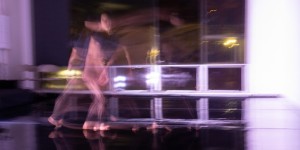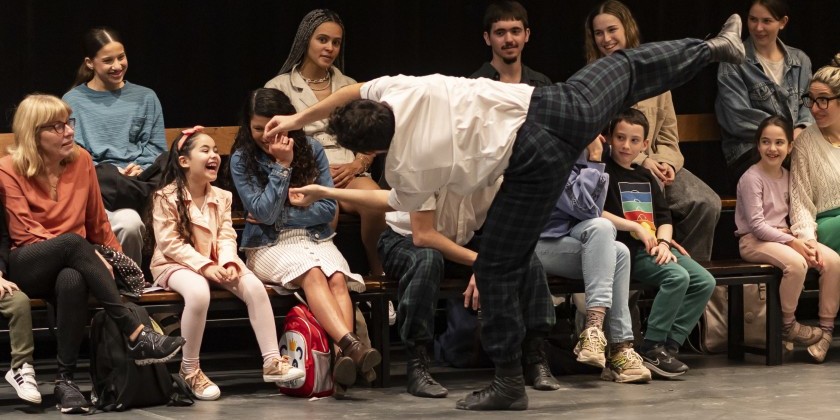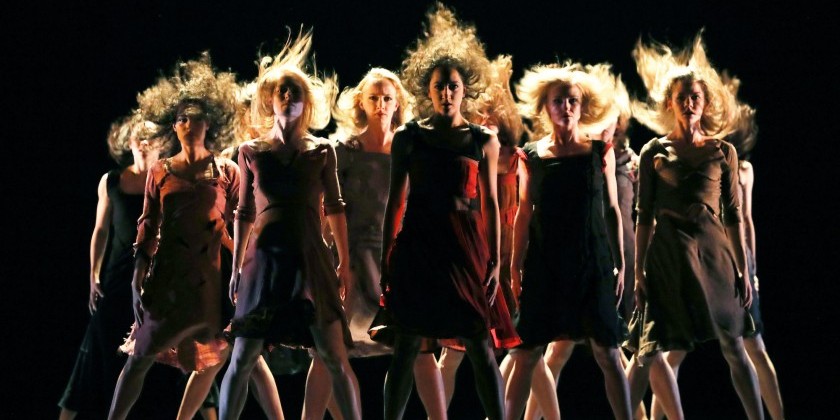IMPRESSIONS: Neil Greenberg's "Betsy" at La MaMa Experimental Theatre Club

IMPRESSIONS: Neil Greenberg’s Betsy at La MaMa Experimental Theatre Club
Choreography and Text: Neil Greenberg
Performers: Paul Hamilton, Opal Ingle, Owen Prum, and Neil Greenberg
Music: James Lo and Zeena Parkins
Lighting: Michael Stiller
Costumes: David Quinn
In the downstairs performance space at La MaMa Experimental Theatre Club, performers watch Betsy. Performers watch the audience watching Betsy. The audience watches each other as they watch Betsy. But who is Betsy?
Although a proper noun, Betsy is not a human being, but rather an accumulation of ideas and an analogy for dance as a person with the capacity to both view and be viewed. She/it /they are also Neil Greenberg’s latest venture in a career-long exploration of meaning making. Here, intimately seated around all four sides of a stage, we delve into heavy hitting topics within the fifty-five-minute Betsy. However, Betsy is not at all heavy.

As the evening begins, Greenberg, dressed in a red tracksuit, performs a step routine on an exercise bench while he greets his guests. Text is projected onto the walls, a practice Greenberg first introduced into his work in 1987. The text in Greenberg’s 1994 "Not About AIDS Dance" was personal, mirroring what he and his cast members were living through. Twenty-eight years later, Betsy’s text is inquisitive: “What is inescapably a context of this work? Covid? The segregation of the dance world? That I finally see the underlying racism of some of the jokes I used to tell?” And, finally, “What is it to show a dance in 2022?”
Greenberg answers the latter question by interacting with the phenomenon of performance itself. While it’s certainly not a new concept, placing the audience around the action rather than at the front allows each viewer a unique experience. Watching other spectators involved in the dance fosters a feeling of community.
Dancers Paul Hamilton, Opal Ingle, Owen Prum, and Greenberg execute the sometimes-awkward choreography —straight legged chasse’s and stiff-kneed skitters— with ease. They perform solo movements that relate to one another but remain separate. Prum possesses a fascinating ability to paint the space with elegance, making his lines of motion visible even after he’s finished dancing. The tilt of Ingle’s chin as he skips evokes a 14th century Botticelli painting with gods and goddesses in mid-frolic. Hamilton’s swiveling hips and circling wrists are profoundly seductive.

In fact, Betsy seems intent on bewitchment. Movement motifs repeat, dissolve, and appear again in a different place or on different bodies giving the evening a hypnotic feel. An understated sensuality is present in Greenberg’s choreography and each performer expresses this distinctively.
The performers travel around the perimeter of the stage mere inches from our legs, then kneel before us for moments of respite. Never looking above our heads or staring out with blank gazes, they meet our eyes with a welcoming kindness and curiosity. Their facial expressions soften and shift, fostering a confidentiality not often present in the performer/audience relationship. We are disarmed and allured.

Greenberg, himself a captivating performer with a gift for blending angular specificity and pedestrian flow, approaches meaning making through inclusivity, insight through intimacy. We all watch Betsy together. We wonder what will happen. We look into one another’s eyes. This allows Betsy to gently explore polarizing topics.
Familiar excerpts of Tchaikovsky’s The Nutcracker filter through the score by James Lo and Zeena Parkins — “Spanish Chocolate,” “Chinese Tea,” and “Arabian Coffee." These dances have in recent years been heavily criticized for cultural appropriation and insulting, over-sexualized portrayals of these cultures. In Betsy, sensuality is a natural outcome of the movement itself rather than a forced conclusion. Infusing their movements with power and delicacy, the all-male cast challenges toxic assumptions about masculinity in dance. Hair tosses, hips swing, and movements often associated with femininity are given masculine weight. Never pontifical or alienating, Greenberg’s Betsy creates a world where ideas feel mutually discovered, not handed down.













